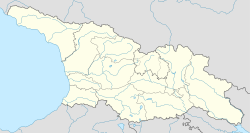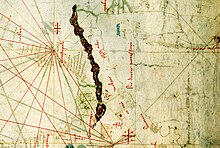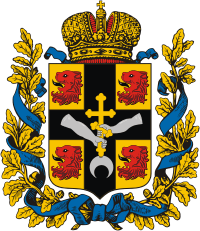Tbilisi
Tbilisi თბილისი | |||
|---|---|---|---|
Capital city | |||
From top: View of Tbilisi, Holy Trinity Cathedral (Sameba), Kartlis Deda, Abanotubani, view from Narikala, Narikala Fortress | |||
| |||
| Coordinates: 41°43′N 44°47′ECoordinates: 41°43′N 44°47′E | |||
| Country | |||
| Established | c. AD 479[citation needed] | ||
| Government | |||
| • Mayor | Kakha Kaladze[2] | ||
| Area | |||
| • Capital city | 504.2 km2 (194.7 sq mi) | ||
| Highest elevation | 770 m (2,530 ft) | ||
| Lowest elevation | 380 m (1,250 ft) | ||
| Population (2018) | |||
| • Capital city | 1,158,700[1] | ||
| • Density | 3,194.38/km2 (8,273.4/sq mi) | ||
| • Metro | 1,485,293 | ||
| Demonym(s) | Tbilisian Tbilisite | ||
| Time zone | UTC+4 (Georgian Time) | ||
| Area code(s) | +995 32 | ||
| GDP[4] | 2017 | ||
| – Total | GEL18.565bil.(~€6.5 billion) | ||
| – Per capita | GEL16,600(~€5,800) | ||
| HDI (2017) | 0.861[5] – very high | ||
| Website | http://www.tbilisi.gov.ge/ | ||
Tbilisi (English: /təbɪˈliːsi, ![]() listen)), in some countries also still known by its pre-1936 international designation Tiflis[7] (/ˈtɪflɪs/ TIF-lis),[6] is the capital and the largest city of Georgia, lying on the banks of the Kura River with a population of approximately 1.5 million people. Founded in the 5th century AD by Vakhtang I of Iberia, since then Tbilisi served as the capital of various Georgian kingdoms and republics. Between 1801 and 1917, then part of the Russian Empire, Tbilisi was the seat of the Imperial Viceroy, governing both Southern and Northern Caucasus.
listen)), in some countries also still known by its pre-1936 international designation Tiflis[7] (/ˈtɪflɪs/ TIF-lis),[6] is the capital and the largest city of Georgia, lying on the banks of the Kura River with a population of approximately 1.5 million people. Founded in the 5th century AD by Vakhtang I of Iberia, since then Tbilisi served as the capital of various Georgian kingdoms and republics. Between 1801 and 1917, then part of the Russian Empire, Tbilisi was the seat of the Imperial Viceroy, governing both Southern and Northern Caucasus.
Because of its location on the crossroads between Europe and Asia, and its proximity to the lucrative Silk Road, throughout history Tbilisi was a point of contention among various global powers. The city's location to this day ensures its position as an important transit route for various energy and trade projects. Tbilisi's diverse history is reflected in its architecture, which is a mix of medieval, neoclassical, Beaux Arts, Art Nouveau, Stalinist and the Modern structures.
Historically, Tbilisi has been home to people of multiple cultural, ethnic, and religious backgrounds, though it is currently overwhelmingly Eastern Orthodox Christian. Its notable tourist destinations include cathedrals Sameba and Sioni, Freedom Square, Rustaveli Avenue and Agmashenebeli Avenue, medieval Narikala Fortress, the pseudo-Moorish Opera Theater, and the Georgian National Museum.
Contents
Names and etymology
The name Tbilisi derives from Old Georgian t′bilisi (თბილისი), and further from tpili (თბილი, "warm"). The name T′bili or T′bilisi (literally, "warm location") was therefore given to the city because of the area's numerous sulphuric hot springs.
Until 1936, the name of the city in English and most other languages was Tiflis, while the Georgian name was ტფილისი (Tpilisi).[8]
On 17 August 1936, by order of the Soviet leadership, the official Russian names of various cities were modified to more closely match the local language.[8] In addition, the Georgian-language form T′pilisi was modernized on the basis of a proposal by Georgian linguists; the ancient Georgian component ტფილი (tpili, "warm") was replaced by the newer თბილი (t′bili).[8] This form was the basis for a new official Russian name (Тбилиси Tbilisi). Most other languages have subsequently adopted the new name form, but some language such as Turkish, Persian, Greek, and German have retained a variation of Tiflis.
On 20 September 2006, the Georgian parliament held a ceremony celebrating the 70th anniversary of the renaming.
Some of the traditional names of Tbilisi in other languages of the region have different roots. The Ossetian name Калак (Kalak) derives from the Georgian word ქალაქი (kalaki) meaning simply "town". Chechen and Ingush names for the city use a form similar to or the same as their names for the country of Georgia (Гуьржех Gürƶex) as does the historical Kabardian name (Курджы Kwrdžy), while Abkhaz Қарҭ (Kart) is from the Mingrelian ქართი (Karti).
History
Early history
Archaeological studies of the region have indicated human settlement in the territory of Tbilisi as early as the 4th millennium BC. According to legend, the present-day territory of Tbilisi was covered by forests as late as 458. one widely accepted variant of Tbilisi foundation myth states that King Vakhtang I of Iberia went hunting in the heavily wooded region with a falcon (sometimes the falcon is replaced with either a hawk or other small birds of prey in the legend). The King's falcon allegedly caught or injured a pheasant during the hunt, after which both birds fell into a nearby hot spring and died from burns. King Vakhtang became so impressed with the hot springs that he decided to clear the forest and build a city on the location.
King Dachi of Iberia, the successor of Vakhtang I, moved the capital of Iberia from Mtskheta to Tbilisi. During his reign began construction of the fortress wall that lined the city's new boundaries. From the 6th century, Tbilisi grew at a steady pace due to the region's strategic location along important trade and travel routes between Europe and Asia.
Foreign domination
Tbilisi's favorable trade location, however, did not necessarily bode well for its survival. Located strategically in the heart of the Caucasus between Europe and Asia, Tbilisi became an object of rivalry among the region's various powers such as the Roman Empire, Parthia, Sassanid Persia, Arabs, the Byzantine Empire, and the Seljuk Turks. The cultural development of the city was somewhat dependent on who ruled the city at various times, although Tbilisi was fairly cosmopolitan.
From 570–580, the Persians ruled the city until 627, when Tbilisi was sacked by the Byzantine/Khazar armies and later, in 736–738, Arab armies entered the town under Marwan II. After this point, the Arabs established an emirate centered in Tbilisi. In 764, Tbilisi – still under Arab control – was once again sacked by the Khazars. In 853, the armies of Arab leader Bugha Al-Turki invaded Tbilisi in order to enforce its return to Abbasid allegiance. The Arab domination of Tbilisi continued until about 1050. In 1068, the city was once again sacked, only this time by the Seljuk Turks under Sultan Alp Arslan.
Capital of Georgia
In 1121, after heavy fighting with the Seljuks, the troops of the King of Georgia David IV of Georgia besieged Tbilisi, which ended in 1122 and as a result David moved his residence from Kutaisi to Tbilisi, making it the capital of a unified Georgian State and thus inaugurating the Georgian Golden Age. From 12–13th centuries, Tbilisi became a regional power with a thriving economy and astonishing cultural output. By the end of the 12th century, the population of Tbilisi had reached 100,000. The city also became an important literary and a cultural center not only for Georgia but for the Eastern Orthodox world of the time. During Queen Tamar's reign, Shota Rustaveli worked in Tbilisi while writing his legendary epic poem, The Knight in the Panther's Skin. This period is often referred to as "Georgia's Golden Age"[9] or the Georgian Renaissance.[10]
Mongol domination and the following period of instability
Tbilisi's "Golden Age" did not last for more than a century. In 1226, Tbilisi was captured by the Khwarezmian Empire Shah Jalal ad-Din and its defences severely devastated and prone to Mongol armies. In 1236, after suffering crushing defeats to the Mongols, Georgia came under Mongol domination. The nation itself maintained a form of semi-independence and did not lose its statehood, but Tbilisi was strongly influenced by the Mongols for the next century both politically and culturally. In the 1320s, the Mongols retreated from Georgia and Tbilisi became the capital of an independent Georgian state once again. An outbreak of the plague struck the city in 1366.
From the late 14th until the end of the 18th century, Tbilisi came under the rule of various foreign invaders once again and on several occasions was completely burnt to the ground. In 1386, Tbilisi was invaded by the armies of Tamerlane. In 1444, the city was invaded and destroyed by Jahan Shah (the Shah of the town of Tabriz in Persia). From 1477 to 1478 the city was held by the Ak Koyunlu tribesmen of Uzun Hassan.
Iranian control
As early as the 1510s, Tbilisi (and the kingdoms of Kartli and Kakheti) were made vassal territories of Safavid Iran.[11] In 1522, Tbilisi was garrisoned for the first time by a large Safavid force.[12][13] Following the death of king (shah) Ismail I (r. 1501-1524), king David X of Kartli expelled the Iranians. During this period, many parts of Tbilisi were reconstructed and rebuilt. The four campaigns of king Tahmasp I (r. 1524-1576) resulted in the reoccupation of Kartli and Kakheti, and a Safavid force was permanently stationed in Tbilisi from 1551 onwards.[12][14] With the 1555 Treaty of Amasya, and more firmly from 1614 to 1747, with brief intermissions, Tbilisi was an important city under Iranian rule, and it functioned as a seat of the Iranian vassal kings of Kartli whom the shah conferred with the title of vali. Under the later rules of Teimuraz II and Heraclius II, Tbilisi became a vibrant political and cultural center free of foreign rule—but, fearful of the constant threat of invasion, Georgia's rulers sought Russian protection in the 1783 Treaty of Georgievsk. Despite this agreement, the city was captured and devastated in 1795 by the Iranian Qajar ruler Agha Mohammad Khan, who sought to re-establish Iran's traditional suzerainty over the region.[15][16][17]
Russian control
In 1801, the Russian Empire annexed the Georgian kingdom of Kartli-Kakheti (of which Tbilisi was the capital), later cementing its rule with the Treaty of Gulistan of 1813,[18][19]which ended Iranian control of Georgia.[20] Tbilisi became the center of the Tbilisi Governorate (Gubernia). Russian Imperial administrators implemented a new European-style city plan and commissioned new buildings in Western styles. Roads and railroads were built to connect Tbilisi to other important cities in the Russian Empire, such as Batumi and Poti. By the 1850s, Tbilisi once again emerged as a major trade and a cultural center. The likes of Ilia Chavchavadze, Akaki Tsereteli, Mirza Fatali Akhundzade, Iakob Gogebashvili, Alexander Griboyedov and many other statesmen, poets and artists all found their home in Tbilisi. The city was visited on numerous occasions by and was the object of affection of Alexander Pushkin, Leo Tolstoy, Mikhail Lermontov, the Romanov family and others. The main new artery built under Russian administration was Golovin Avenue (present-day Rustaveli Avenue), on which the Viceroys of the Caucasus established their residence. For much of the 19th century, Tbilisi's largest ethnic group was Armenian, who, at some point, formed 74.3% of the population.[21]
Brief independence
After the Russian Revolution of 1917, the city served as a location of the Transcaucasus interim government which established, in the spring of 1918, the short-lived independent Transcaucasian Federation with the capital in Tbilisi. At this time, Tbilisi had roughly the same number of Armenians as Georgians, with Russians being the third largest ethnic group.[22] It was here, in the former Caucasus Vice royal Palace, where the independence of three Transcaucasus nations – Georgia, Armenia and Azerbaijan – was declared on 26 to 28 May 1918. After this, Tbilisi functioned as the capital of the Democratic Republic of Georgia until 25 February 1921. From 1918 to 1919 the city was also consecutively home to a German and British military headquarters.
Under the national government, Tbilisi turned into the first Caucasian University City after the Tbilisi State University was founded in 1918.[23] On 25 February 1921, the Bolshevist Russian 11th Red Army invaded [24][25] Tbilisi after bitter fighting at the outskirts of the city and declared Soviet rule.
Soviet rule
In 1921, the Democratic Republic of Georgia was occupied by the Soviet Bolshevik forces from Russia, and until 1936 Tbilisi functioned first as the capital city of the Transcaucasian SFSR (which included Armenia, Azerbaijan, and Georgia), and afterwards until 1991 as the capital of the Georgian Soviet Socialist Republic. During Soviet rule, Tbilisi's population grew significantly, the city became more industrialized, and it also came to be an important political, social, and cultural centre of the Soviet Union. In 1980 the city housed the first state-sanctioned rock festival in the USSR. As a major tourist destination for both Soviet citizens and foreign visitors, Tbilisi's "Old Town" (the neighborhoods within the original city walls) was reconstructed in the 1970s and 1980s.[26]
Tbilisi witnessed mass anti-Russian demonstrations during 1956 in the 9 March Massacre, in protest against the anti-Stalin policies of Nikita Khrushchev. Peaceful protestsoccurred in 1978, and in 1989 the April 9 tragedy was a peaceful protest that turned violent.
Post-independence
Since the break-up of the Soviet Union, Tbilisi has experienced periods of significant instability and turmoil. After a brief civil war, which the city endured for two weeks from December 1991 to January 1992 (when pro-Gamsakhurdia and Opposition forces clashed), Tbilisi became the scene of frequent armed confrontations among various mafia clans and illegal business operators. Even during the Shevardnadze Era (1993–2003), crime and corruption became rampant at most levels of society. Many segments of society became impoverished because of unemployment caused by the crumbling economy. Average citizens of Tbilisi started to become increasingly disillusioned with the existing quality of life in the city (and in the nation in general). Mass protests took place in November 2003 after falsified parliamentary elections forced more than 100,000 people into the streets and concluded with the Rose Revolution. Since 2003, Tbilisi has experienced considerably more stability with decreasing crime rates, an improved economy, and a real estate boom.[27] During the 2008 South Ossetia war the Tbilisi area was hit by multiple Russian air attacks.
After the war, several large-scale projects were started, including a streetcar system,[28] a railway bypass and a relocation of the central station[29] and new urban highways.[30] In June 2015, a flood killed at least twelve people and caused animals from the city's zoo to be released into the streets.[31]
'코카서스' 카테고리의 다른 글
| <펌> Azerbaijan (0) | 2019.02.15 |
|---|---|
| <펌> Georgia (Country) (0) | 2019.02.15 |
| <펌> Narikala (0) | 2019.02.15 |
| <펌>Greater Armenia, Ancient Kingdom, Armenia (0) | 2019.02.10 |
| <펌> Armenian Highlands (0) | 2019.02.02 |






















